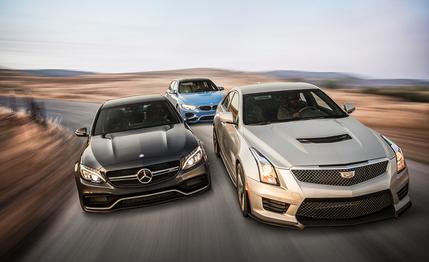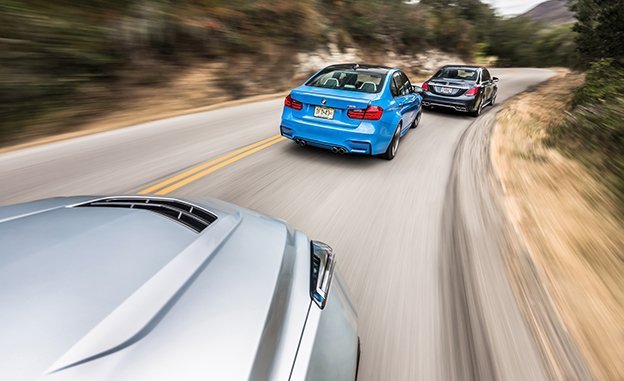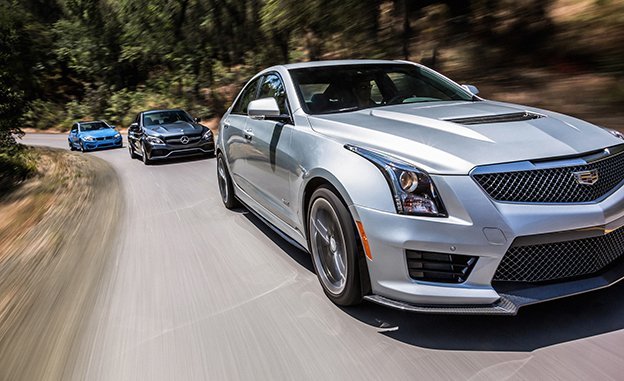
 Comparison Tests
From the August 2015 issue
Comparison Tests
From the August 2015 issue
The first BMW M3, that little snarly sweetheart E30 from the Reagan years, didn’t invent its genre. There were heroic versions of otherwise mainstream cars long before it, starting with the Cosworth Vega and VW Golf GTI. Well, actually, starting with the Pontiac GTO. No, really, starting with the Chevy II Nova Super Sport. Okay, fine, starting with the 1949 Olds “Rocket” 88. Discussion closed. But while the M3 wasn’t a new idea, through successive generations of sublimity it became a benchmark for a narrow niche: practical sports sedans with enhanced capability. They’re fast but also reasonably roomy and road-trip comfortable. That segment, let’s call it compact radar bait, is now so formulaic that our three cars, the current M3 and the new Cadillac ATS-V and Mercedes-AMG C63 S, are all but track-sheet clones of each other.
Just look at the VBOX readouts on the ensuing pages. A mere 0.1 second separates the quarter-mile times of the three cars. Ditto for zero to 60. All three circle a skidpad close to 1.0 g, and their speeds through the slalom are within 1.1 mph of each other. The BMW and Cadillac are practically the same length, while the Benz, that luxurious mini S-class, is only about three inches longer.


But boy, are there differences in personality and execution, and we’ll get to that. Meanwhile, we picked sedans over coupes because that’s what sensible people buy, and the new C63 coupe won’t be here for a while. We picked automatics, in part because the Benz only comes as an automatic and only with the Speedshift MCT seven-speed, a merging of ideas that substitutes a torque converter with a stack of clutch plates so that, in effect, a conventional planetary-gear transmission offers dual-clutch shift quickness. Plus, we already have a long-term test going of the manual M3, and we already tested a manual ATS-V in coupe form.
The M3 is the most familiar, having made its debut last year with its 425-hp twin-turbo inline-six. This car’s optional $550 Yas Marina Blue Metallic is a shade of pale azure that otherwise appears on delicate undergarments and the walls of newborns named Jackson or Zoe, as well as on the BMW M logo. The M3 has the second-cheapest base price at $62,950, but once the options tractor beam locks on, you can get pulled into fantastic realms. Of the (gasp!) $21,375 in extras on this M3, the most disposable ones include the automatic, which costs $2900, and the carbon-ceramic brake system at $8150.
Not long ago, Cadillac belonged in this match as much as Dick Cheney belongs in the CrossFit Games, but proof that dedicated, well-intentioned people can change anything lies in the ATS-V. You’ve got 464 horsepower from a twin-turbo 3.6-liter V-6 and eight speeds with which to send it aft. You’ve got tidy dimensions and a curb weight that falls in the middle of the pack. You’ve even got the right tires, Michelin Pilot Super Sports, the segment standard. Except that the tires on the ATS-V are custom-made for Cadillac. We could see wider shoulder blocks and fatter center traction bands. These GM guys are serious.


They’re also serious about not letting the brand’s decades of negative baggage weigh down the prices. The ATS-V starts just below the M3 at $61,460, and you’re in for some hefty option prices, such as $2000 for the automatic and $6195 for a track package that includes carbon-fiber accents, a low-mass battery, and the Performance Data Recorder video system from the Chevy Corvette. You must also pay $305 to add floor mats, a tow hook, and a tire-inflation kit, items that are typically standard on other cars.
The numbers on the back of Benzes have all but ceased to mean anything, the 63 on our C63 S referring to a 4.0-liter twin-turbo V-8. The S addendum shoves the horsepower rating up by 34 to 503, the top speed up to 180 mph, and the starting price up by $8000, to $72,825. The options’ orgy on this one adds $18,760 and includes $2500 performance seats and $5450 ceramic rotors. Why are these brakes so much cheaper than the M3’s? Because they’re only ceramic in front, leading to the odd phenomenon of the rear 19-inch forged wheels (at $1250 for the set) darkening with soot while the fronts remain shiny. Again, an option you can do without.
Is the M3 finally washed up? We’ve got full tanks, radar detectors affixed, and miles of California roads to find out, so let’s go.